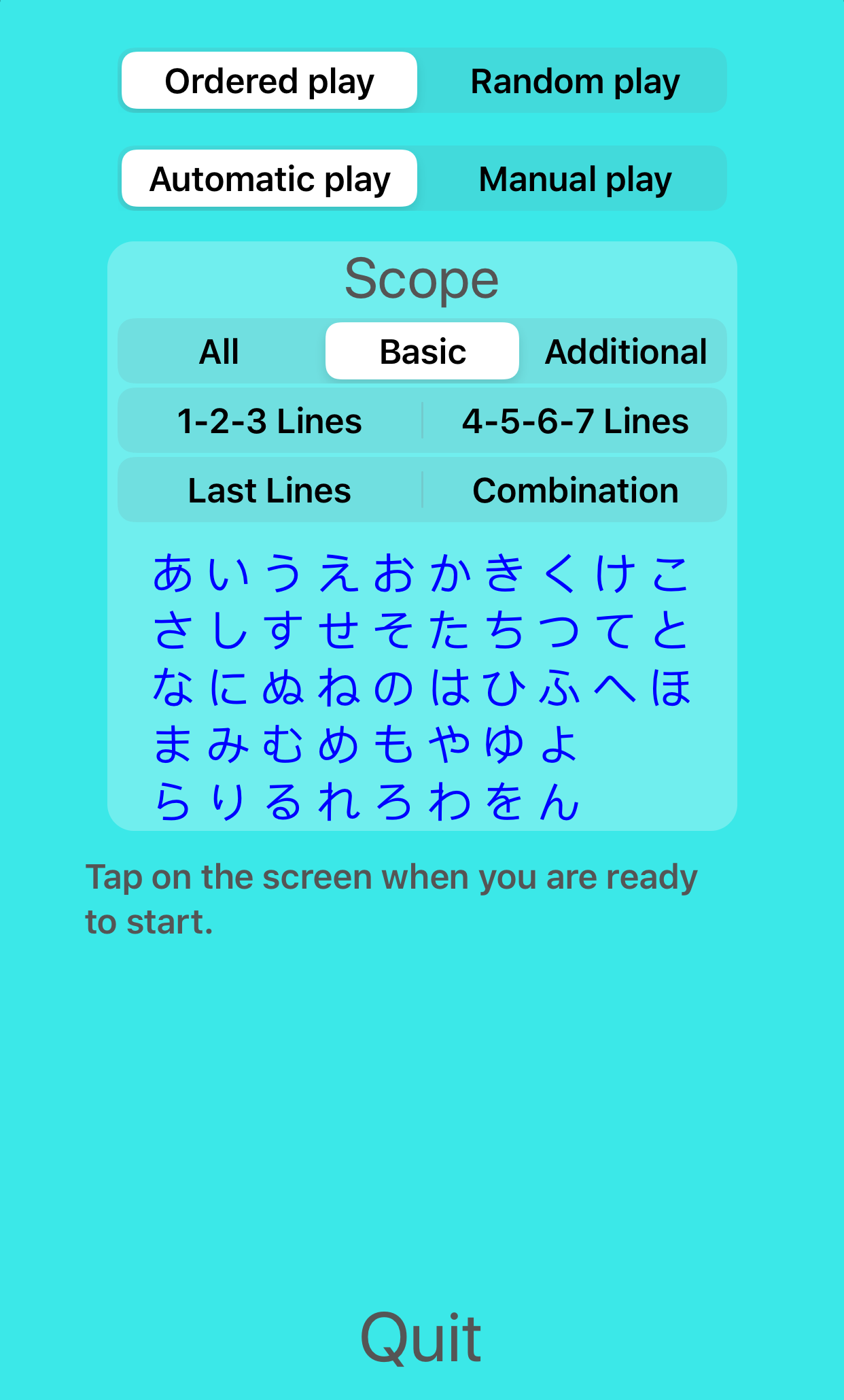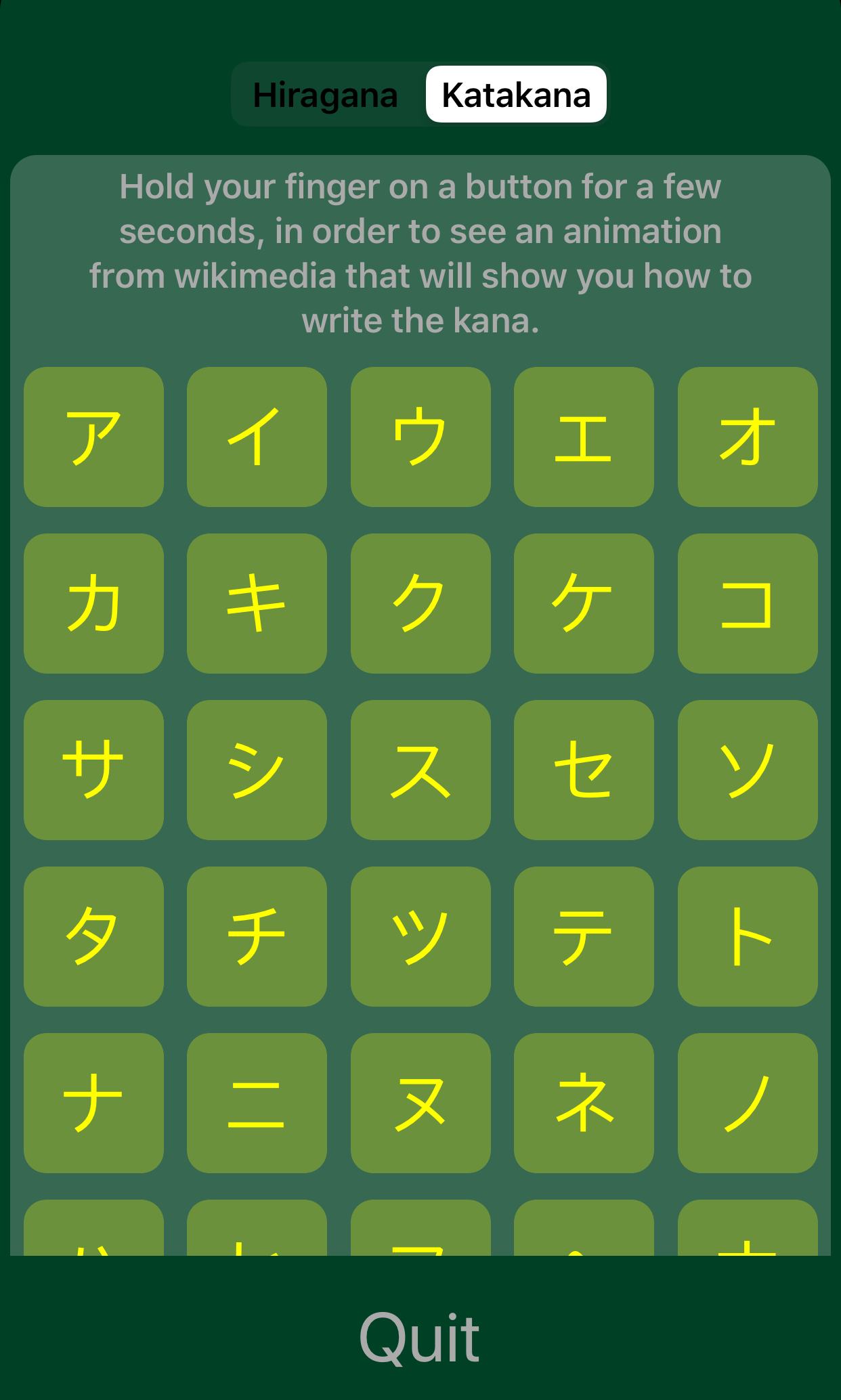This application is meant for learning the kana Japanese syllabic reading and writing system. Japanese has a fairly unique kind of "alphabet" which is neither like the one we have in western countries, where in order to be able to read something like "PARIS", "WASHINGTON" or "ELEPHANT", one needs not only to know the symbols (letters), but also a number of rules on how to glue them together in order to make proper syllables. Nor is it like Chinese ideograms where each symbol comes bound with a given meaning.
In the Japanese kana system the symbols have no particular meaning, but unlike our western alphabet, the process for learning how to read is much simpler, for the reason that one only needs to know how to read each symbol, without any need for extra gluing rule like we do with the latin alphabet. In other words when one reads the symbols, one after the other, - like in a text for children entirely written in kana - one reads, and that's it.
The method used in this app is based on listening and on the belief that one should directly associate a sound with a symbol. There are four Japanese native narrators that can be selected in this app.
As a piece of advice, if you are interested in learning Japanese on a good starting base. Learn kana (that is Hiragana and Katakana) this way, and you are doing yourself a favor on the long run.
Do not learn that:
あ is a
う is u
き is ki
け is ke
ら is ra
ほ is ho
...etc...
By doing that you would be exposing yourself to various possible pronounciation mistakes which may vary according to your native language. The obvious reason being that a western person seing something like this:
-a-u-ki-ke-ra-ho .......
has already in mind some way of her/his own for reading and pronouncing it, varying based on her/his own language. And this way is certainly not the "Japanese way". So in order to avoid trouble by possible confusion, use a good method and learn by listening. For those who will argue that they have a visual memory rather than a hearing memory and it is faster for them to learn using some sort of romanization I say:
It is far better to learn slowly something right than to learn fast something false!
As a matter of fact it may be useful to be reminded that we all learned our own native language by listening first.
Here is the top screen of the app.

You can see appear the five sections of the app. The first two will enable you to listen and familiarize yourself with the two kana sets, namely the hiragana and the katakana. The third one gives you the list of what is known as the 50 sounds table. The fourth section is a training area, where you can practice your skills; once you think you have explored the first three parts long enough. Finally the fifth section is an evaluation area where you will want to go once you feel confident and are ready to be challenged with questions. This last part is a bit like having a private teacher asking you questions to test your knowledge, the teacher is progressively letting you alone with things you obiously know and quizzing you more and more on parts that you seem to have a hard time to remember.
Here is the preferences screen of the app.

In the app one can scroll down to see more contents. This is where you can customize the settings to fit your needs and tastes.
Here is the hiragana screen of the app.

This is where you get to know the hiragana, you can play in various ways to familiarize yourself with them and learn them here.
Here is the 50-sounds screen of the app.

This is a kind of reference screen, where you can find any kana or combination you want with its sound. This is also where you can find out how a character should be written, by looking at an animation.
Go to iTunes and download the app by clicking on the icon below. The QR code allows you to go to iTunes by taking a picture using a QR code reader application.
While the focus of the app presented above is about rembering the set of kana by listening and seeing. It is also very important for a student to know how to properly write these characters, with the correct stroke order. For that purpose, below are some useful links. Each cherry blossom flower has a URL attached, click it.
You should not care too much if you cannot follow all the information because it is in Japanese. The main point is for you to pick up the information by looking at the graphics and observing how a given character is written. Click the characters and you will see relevant images, with stroke order indicated. In the Youtube videos (three last links), look at the way the teacher writes.
Beside, if you intend to speak Japanese at some point. It can only be a very good exercise to listen to a native speaker, even if you do not understand.
Videos:

